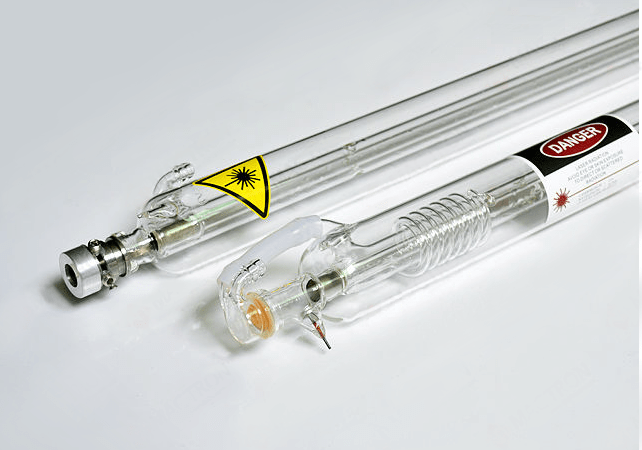If you’re wanting to understand the differences between a DC and an RF excited CO2 laser tube – to help make a purchase decision – then this article is a good place to start. One of the first decisions when buying a CO2 laser for cutting and/or engraving is the option between a Direct Current or Radio Frequency excited laser tube. To understand the differences in each laser, we must first understand how each laser works. Direct current (DC) lasers are most commonly made of glass. Inside this glass tube is a mixture of gases, carbon dioxide, helium, nitrogen, hydrogen and xenon. Electrical energy is sent through the tube. This energy excites the gases resulting in a direct electrical discharge. The discharge creates a photonic laser beam that bounces back and forth until a certain level of energy is attained, then the photonic (light) beam exits the laser at one end. This infrared beam is invisible but powerful and once focused can be used to cut or engrave various materials. By the way the word LASER is actually an acronym that describes this process: Light Amplification by Stimulated Emission of Radiation.
An alternative way to transfer energy into the gas is via. radio frequency (RF). RF tube technology is commonly referred to as “metal” tubes. RF excitation produces a pulsed laser with an extremely quick repeatability. Unlike the parallel discharge in a DC excited tube, the RF laser discharges perpendicular to the resonator.
Head to Head Comparison
When deciding which laser is best suited for your application, understanding the pros and cons of each laser is critical. Below we break down the major factors when considering these different technologies.
Cost: DC lasers made of glass are roughly 10% of the price of RF lasers. This cost advantage is a result of a lower technology and manufacturing cost. Edge: DC
Cutting Performance: Both lasers maintain very high quality cuts. The edge quality is very similar. However, because RF lasers are pulsed, some materials may show a slightly rough edge. This is evident in acrylics. With that being said, this difference in quality is hardly noticeable to most users. Edge: Draw
Engraving Performance: RF lasers generate a smaller spot size out of the output window of the laser. The smaller the spot size, the finer the engraving detail. For high precision engraving, this smaller spot size makes a difference. There are many applications where this advantage in quality will not make itself apparent. Edge: RF
Longevity: Experience has shown that RF lasers last 4-5 times longer than DC lasers. This longevity can help offset the initial higher cost of the RF laser. The gases inside RF lasers can sometimes be refilled but this process can be more expensive than the replacement cost of new DC laser. Edge: RF
Comparing Laser Power RF vs. DC
If you were to compare a 100W RF to a 100W DC tube then assuming all things are equal – the power is the same. Power is power; However, RF power focuses that same energy into a more dense, smaller spot size. The quality and stability of that beam is better as well. For detailed etching RF can offer that advantage. However, with cutting you can afford to ‘buy’ much more cutting power compared to the cost of RF. So, determining what you will be using your laser for will help you make that decision.
Boss Laser Advantage
Boss Laser is one of the only North American companies to offer both RF and DC lasers. Our expert knowledge in photonics allows us to help our customers pick the right machine for their needs. Whether you represent a large corporation or are a self-employed entrepreneur, we will have the right laser for you.
If you have any further questions about theses lasers please feel free to contact us directly at techsupport@bosslaser.com or 888-652-1555.
108
